Serie A champions Juventus faced off against league strugglers Atalanta on Wednesday evening, with both sides hoping to pick up much needed three points. However, the game ended in a stalemate, which may be a fair reflection over the course of the ninety minutes.
Gian Piero Gasperini’s side have been quite inconsistent this season off the back of a fantastic 2019/20 campaign where they reached the UEFA Champions League semi-final and managed to finish third in Serie A. The Bergamo based team moved up to eighth place following the draw against Juventus, and they will be hoping that this result will hold them in good stead for Sunday’s bout against Roma.
Juventus on the other hand are still unbeaten in the league but have now been held to six draws in their 12 Serie A matches in the current campaign. In comparison with last season, they only had five draws under Maurizio Sarri. Considering both Milan and Napoli drops point on Wednesday too, a draw seems more so to be two points dropped rather than a point gained.
This article will be a tactical analysis of the draw between the two sides. It will be an in-depth analysis of the strengths and weaknesses of both sides in their tactics, throughout the game, as well as taking a look at where each team could have improved in their set-up.
Lineups and formations:
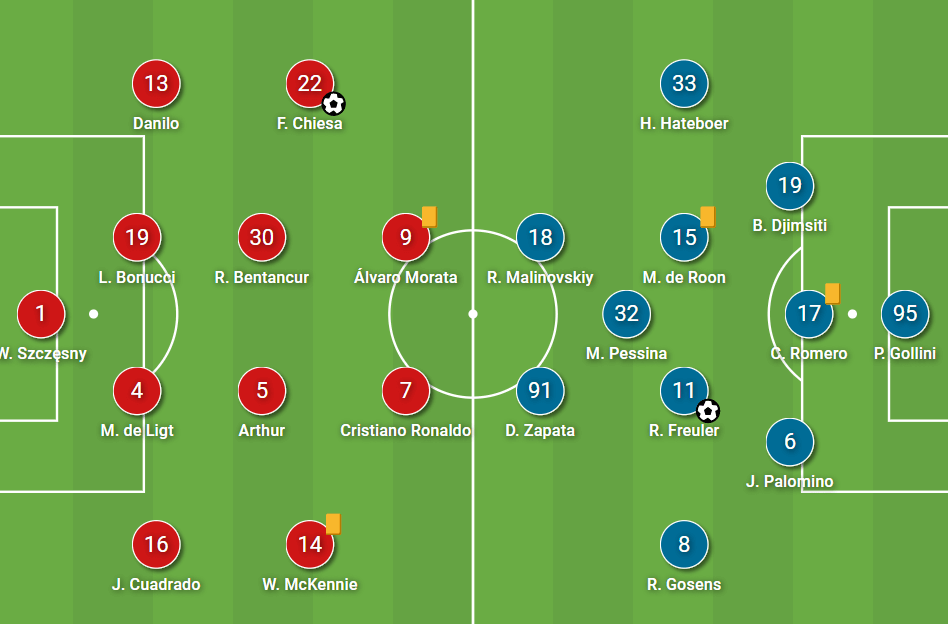
Both sides came into this game off the back of two brilliant victories with respect to the opponents. Juventus had beaten Genoa 3-1 at the weekend away from home, whilst Atalanta had put Fiorentina to the sword playing some of the best football from them so far this season with a 3-0 win against La Viola.
For I Bianconeri, there were only three changes made by Andrea Pirlo. Juventus deployed a 4-4-2 yet again as their base formation. Danilo came back into the side at left-back over Alex Sandro who took his place on the bench.
Arthur Melo also started this game next to Rodrigo Bentancur rather than the usual Adrien Rabiot, meanwhile Paulo Dybala was dropped to the bench in place of Alvaro Morata despite the Argentine’s goal against Genoa in their preceding game.
For the visitors, Gasperini kept with their typical 3-4-1-2 and only made a single change from their trouncing of Cesar Prandelli’s Fiorentina in the previous game. Jose Luis Palomino was forced to come in at left centre-back for the injured Rafael Toloi, partnering next to Cristian Romero and Berat Djimsiti in a three-man backline.
Juventus’ set-up with established possession:
Under Pirlo, Juventus are quite a possession-oriented side, much like they were under his predecessor, Sarri. They like to play out from the back and build their way through the thirds with progressive parts, although they are also not afraid to go long. Against Gasperini’s side, they maintained 54.12 percent of the ball possession throughout the game compared to Atalanta’s 45.88 percent.
Despite I Bianconeri’s base formation being a 4-4-2, predominantly when they are out of possession, they tend to use a 3-4-1-2/3-2-3-2-type structure whilst in possession, with Danilo shifting inside as a left centre-back alongside Leonardo Bonucci and Matthijs de Ligt to from the back three.
Juan Cuadrado would push higher up the pitch in line with the central midfielders and play as a wingback, dropping short into the right-back position should de Ligt need a wide passing option.
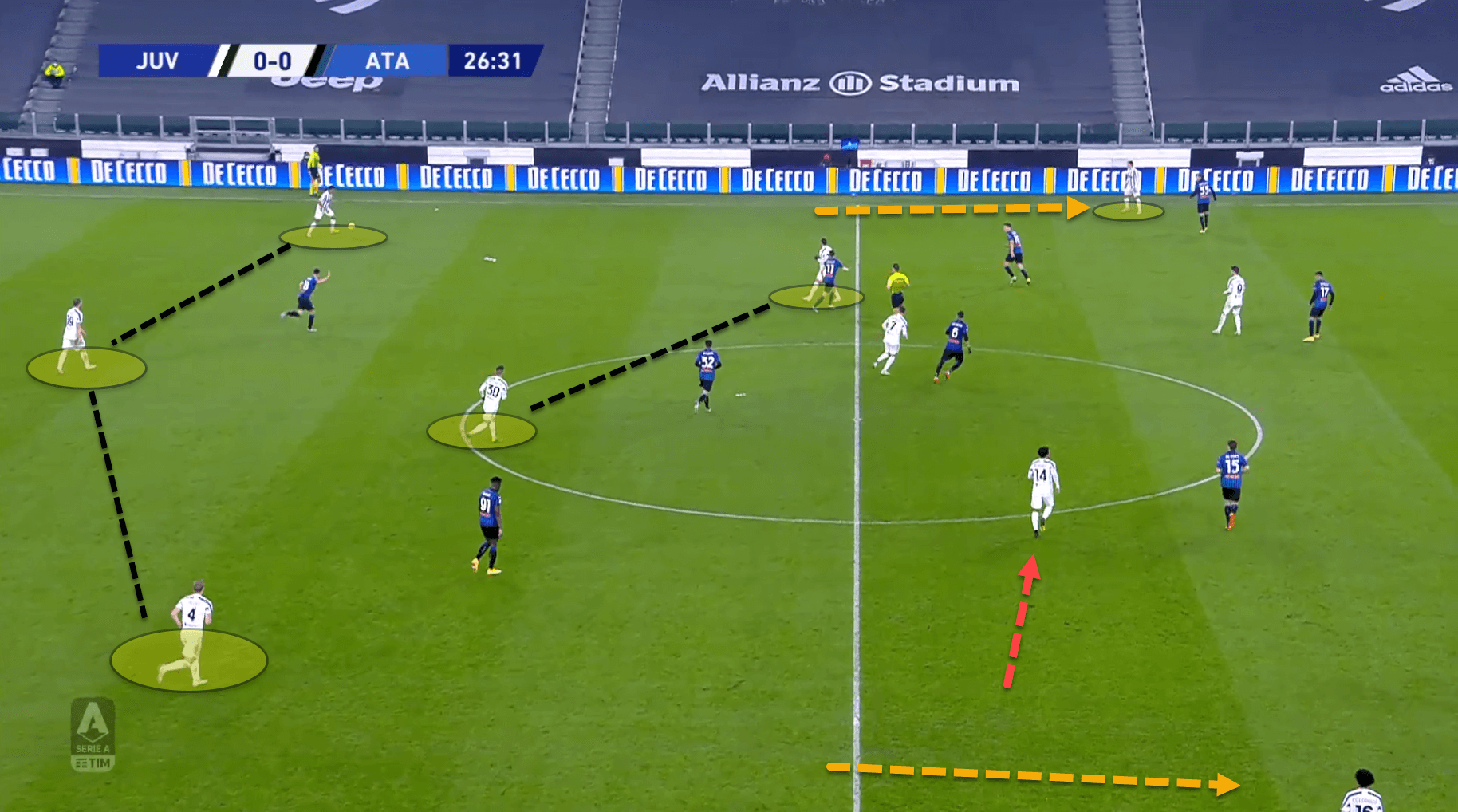
Here, we can see a typical example from Wednesday’s game of how Juventus set up against Atalanta in the established possession phase. The three centre-backs have covered the width of the pitch with both de Ligt and Danilo almost playing as auxiliary fullbacks to help circulate the ball around the backline.
Cuadrado’s positioning can also be seen in the above image. The Colombian was given license to venture forward when Weston McKennie moved inside to play off the centre-forwards, which created a 3-2-3-2 structure. However, this set-up was quite fluid due to the constant movements and interchanges of Juventus’ forward line, including McKennie, who operated like a number 10.
Sitting behind Atalanta’s first line of press was their double-pivot of Bentancur and Rabiot/Arthur – who were very flexible in their positioning throughout the game, drifting into spaces between the centre-backs if Juventus were struggling to play through Atalanta.
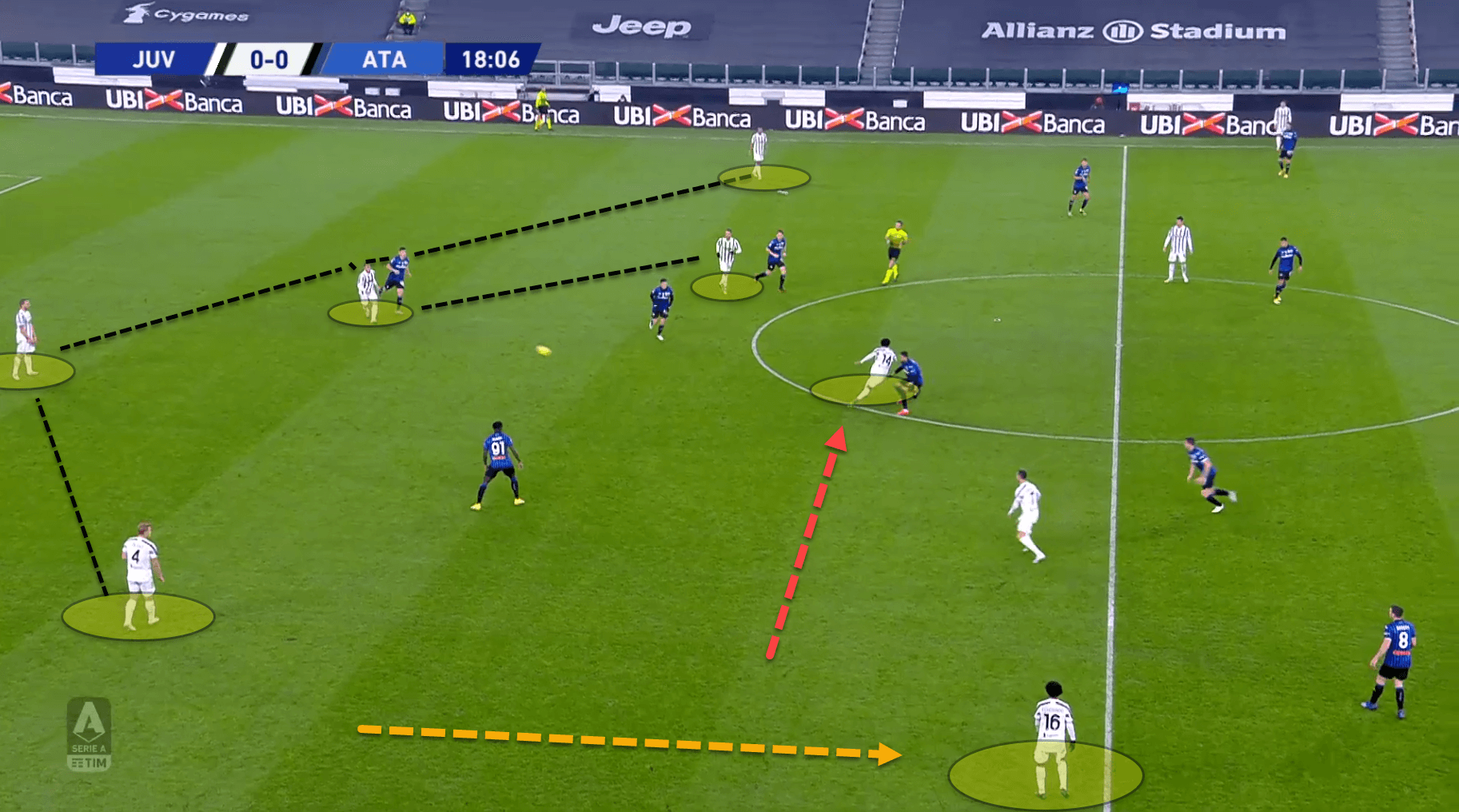
Once again, we can see this type of build-up play from Pirlo’s side. However, despite the solid base structure in possession, Juventus struggled to play through their opposition’s high press at times.
Atalanta cutting off the pitch:
As Juventus do tend to play through the thirds to progress up the pitch, Atalanta deployed a man-oriented pressing system and cut off their opponent’s left side of the pitch. They did this by having Ruslan Malinovskyi angle his run when pressing Bonucci as the central centre-back to prevent him from being able to play out to Danilo or Federico Chiesa on the left flank.
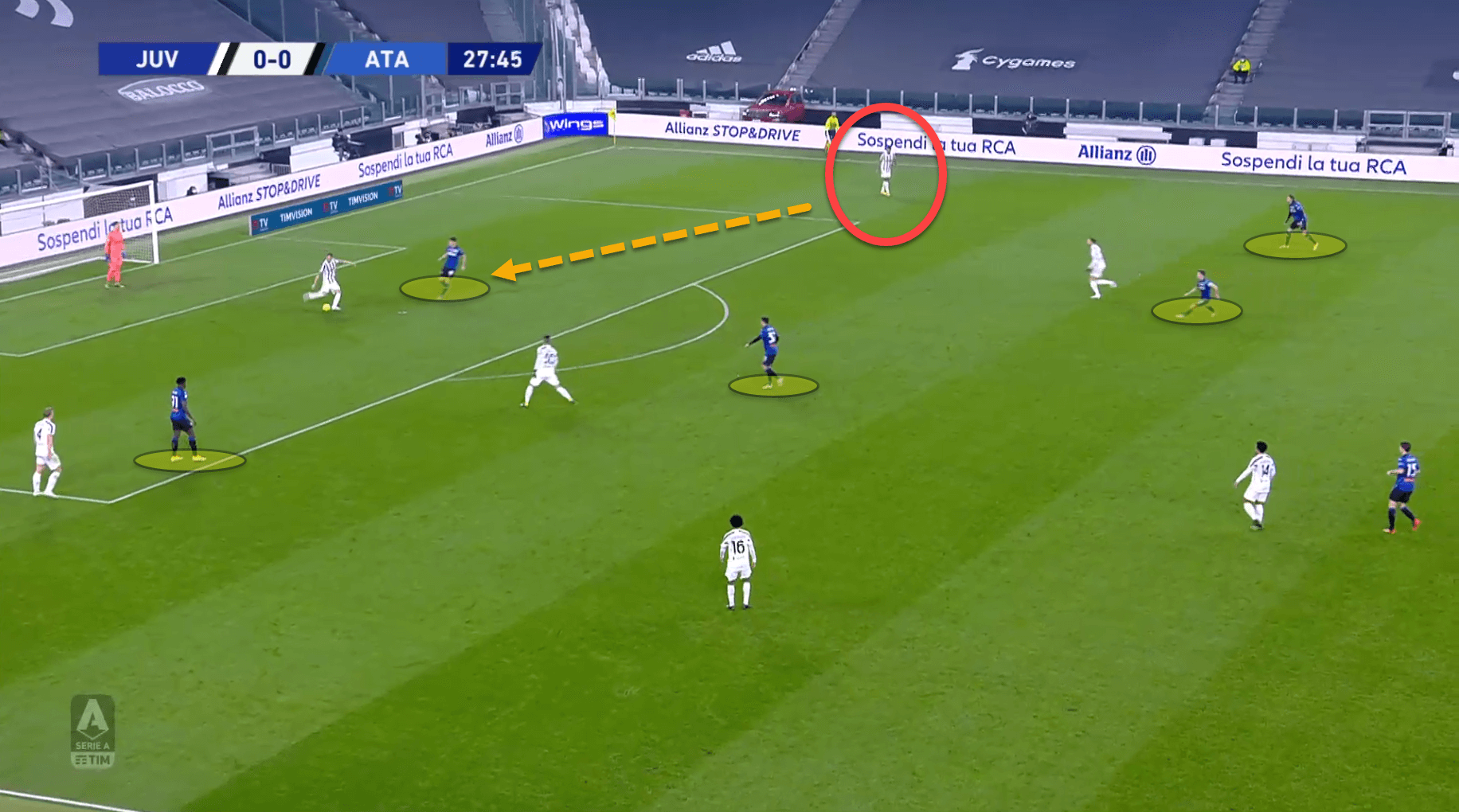
Here is an example of this man-to-man pressing system being put into effect successfully. Atalanta would press high with each player marking one of the Juventus players tightly, very similar to the pressing scheme deployed by Marcelo Bielsa’s Leeds United.
Duvan Zapata and Malinovskyi would mark two of Juventus’ three centre-backs when I Bianconeri had possession of the ball with their backline. Zapata would mark de Ligt whilst Malinovskyi would press high and mark Bonucci.
The most important player was Malinovskyi who would angle his run to aggressively press the Italian centre-back whilst cover-shadowing Danilo on the left side, blocking the passing lane to the Brazilian. This halved the pitch that Juventus had to play into and forced the home team to either play long, short through the centre, or else to the right. As seen above, Bonucci chose to go long on this occasion.
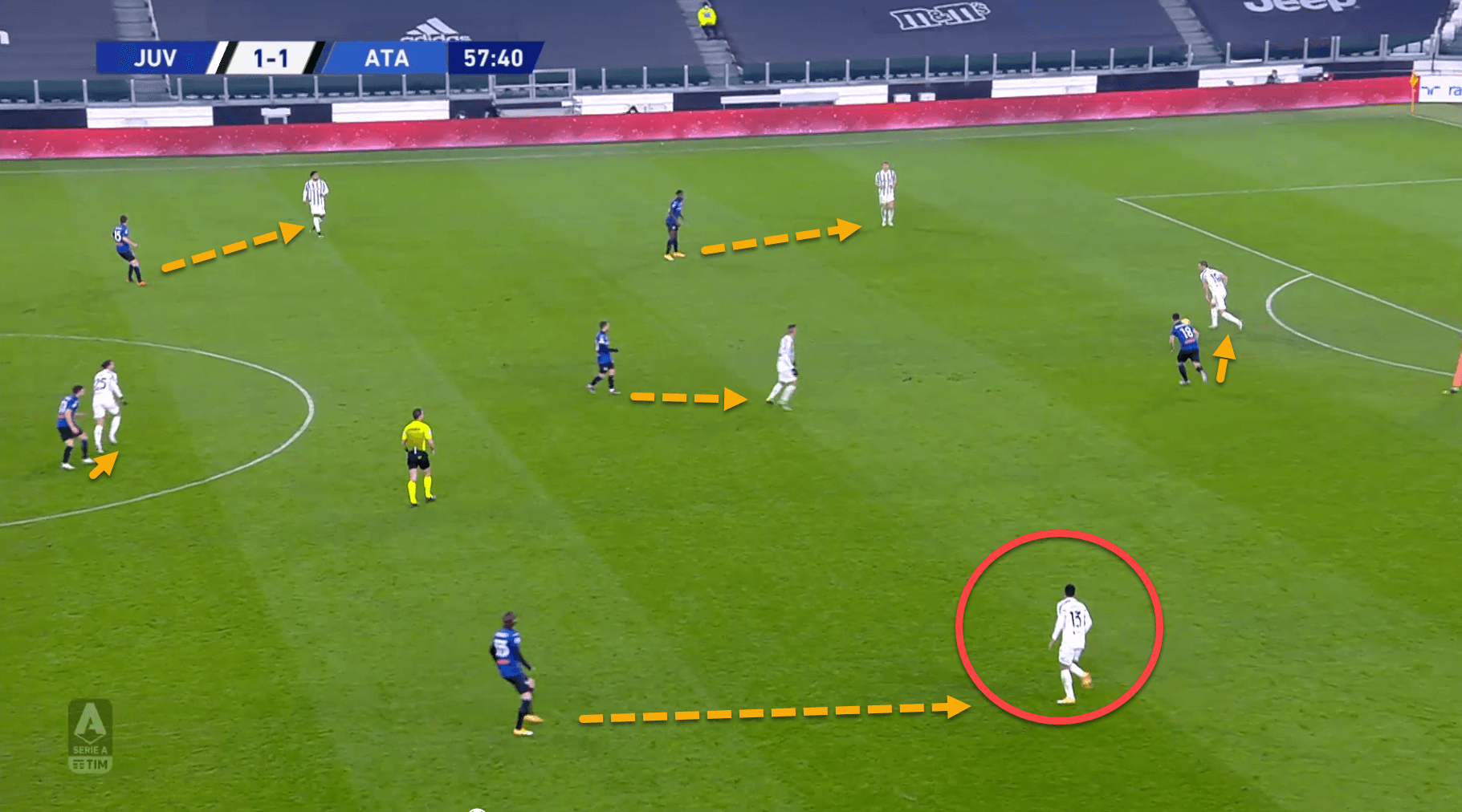
Once again here, we see Malinovskyi’s angled run cutting off the ball supply to Danilo, essentially cutting off half of the area that Juventus have to play into. Atalanta’s man-to-man system also made it extremely difficult for Pirlo’s side to be able to build-up through the thirds and stifled their build-up play on more than one occasion.
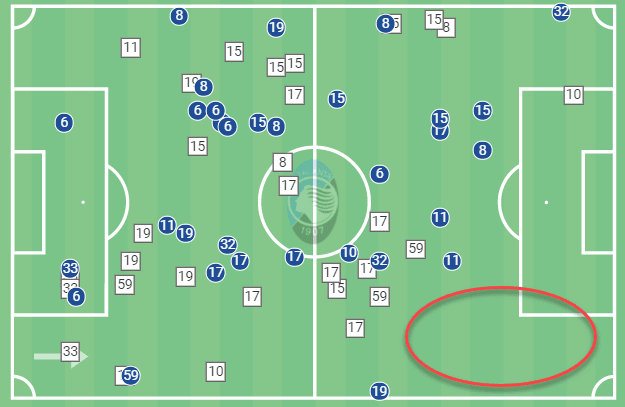
This can strangely be seen in this data viz of Atalanta’s defensive duels. There is a clear lack of action on the area of the pitch where Danilo occupied.
Juventus adapting:
Juventus were forced to adapt, and adapt, quickly to the high pressure put on them by La Dea. Beforehand, we touched on I Bianconeri’s midfield double-pivot being quite flexible in their positioning. In this game, they took flexibility to another level.
Both Bentancur and Rabiot (and Arthur until the early substitution) tended to split quite wide and allow Atalanta’s midfield to be stretched, creating space for the backline to progress the ball into.
As analysed previously, Gasperini deployed a strict man-to-man pressing system with his team, not only with their forward line, but with their midfielders too. To combat this, and to bypass Juventus’ midfield completely at times, the double-pivot would split and create huge spaces centrally to play through, which can be seen in the following in-game footage:
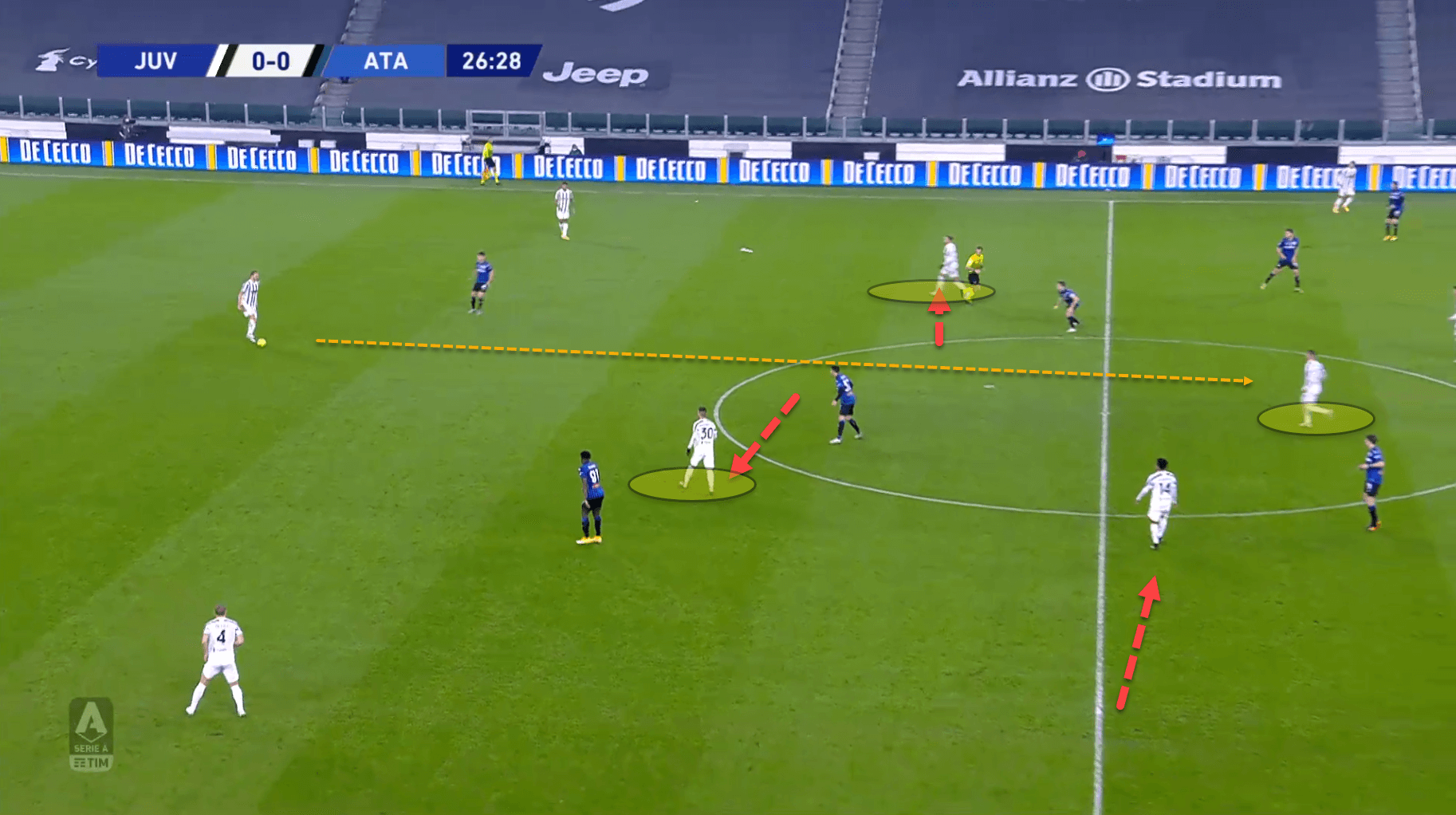
Here, Bentancur and Rabiot have split quite wide from each other, and due to the tight man-marking system used by Atalanta, their markers followed them leaving a passing lane open in the middle of the pitch for Bonucci to completely bypass his own midfield and play to one of the forwards who dropped.
McKennie pushed inside as always and this meant that Marten de Roon was caught in two minds of whether to go to Ronaldo who dropped short, or else stay and mark McKennie. This was executed quite well by Juventus and it gave them another variation to play through their opponent, but the forwards failed to capitalise on situations like this. Another example can be seen here:
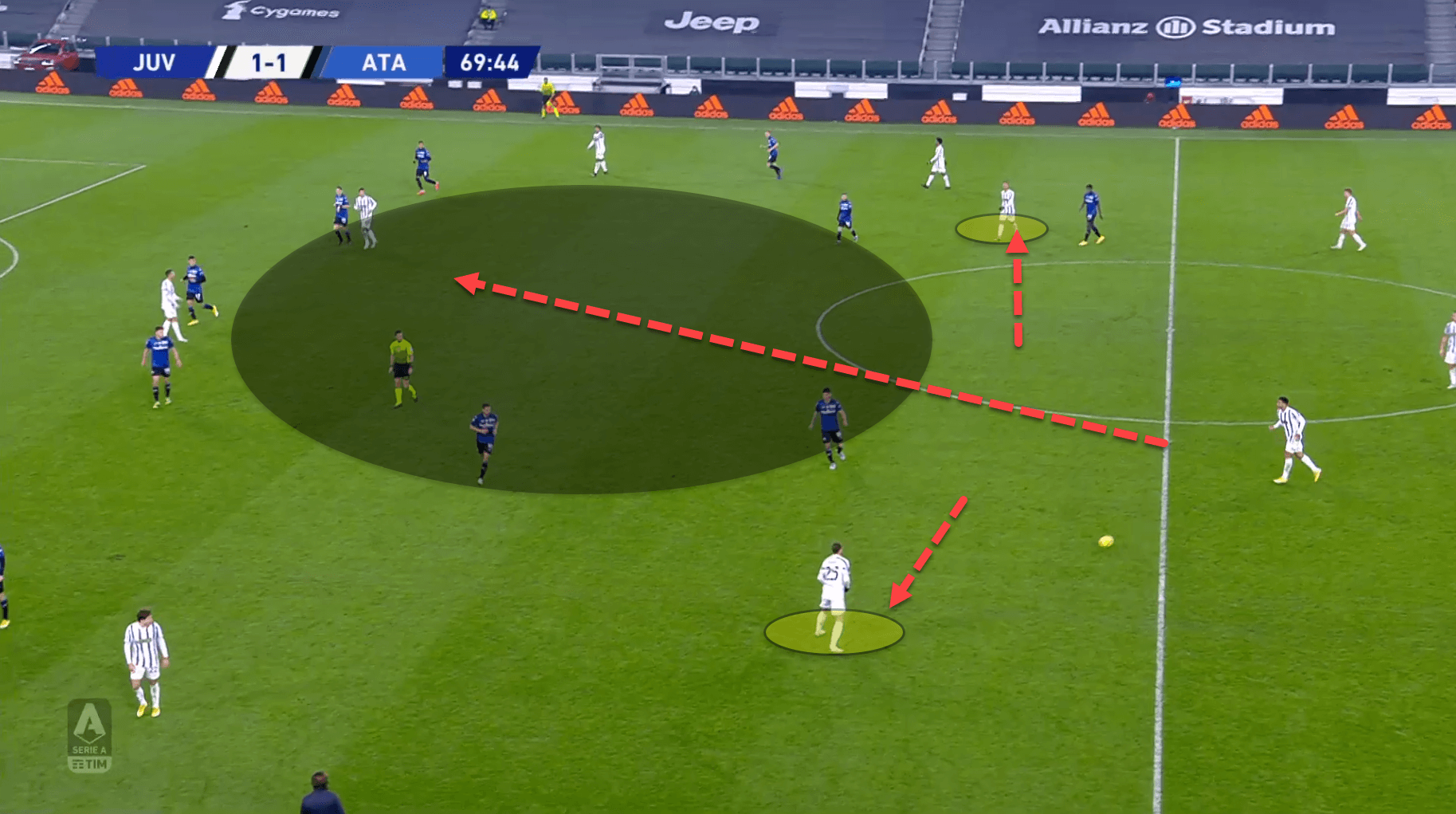
Yet again Rabiot and Bentancur split wider which stretched Atalanta’s midfield allowing for huge gaps to be present for I Bianconeri to play through. However, on this occasion, Juventus did not use the progressive passing lanes.
Transitions tie the game:
This game was quite interesting from a tactical standpoint. Both teams cancelled each other out with their defensive and offensive set-ups, but it was the attacking transitions where both teams scored from.
The transitions were so vitally important in the end result to this game. However, it certainly was not an area of the game that each coach emphasised during their preparation. Juventus had only one counterattack throughout the entire match, according to Wyscout, and they managed to score from it with an excellent strike from Chiesa.
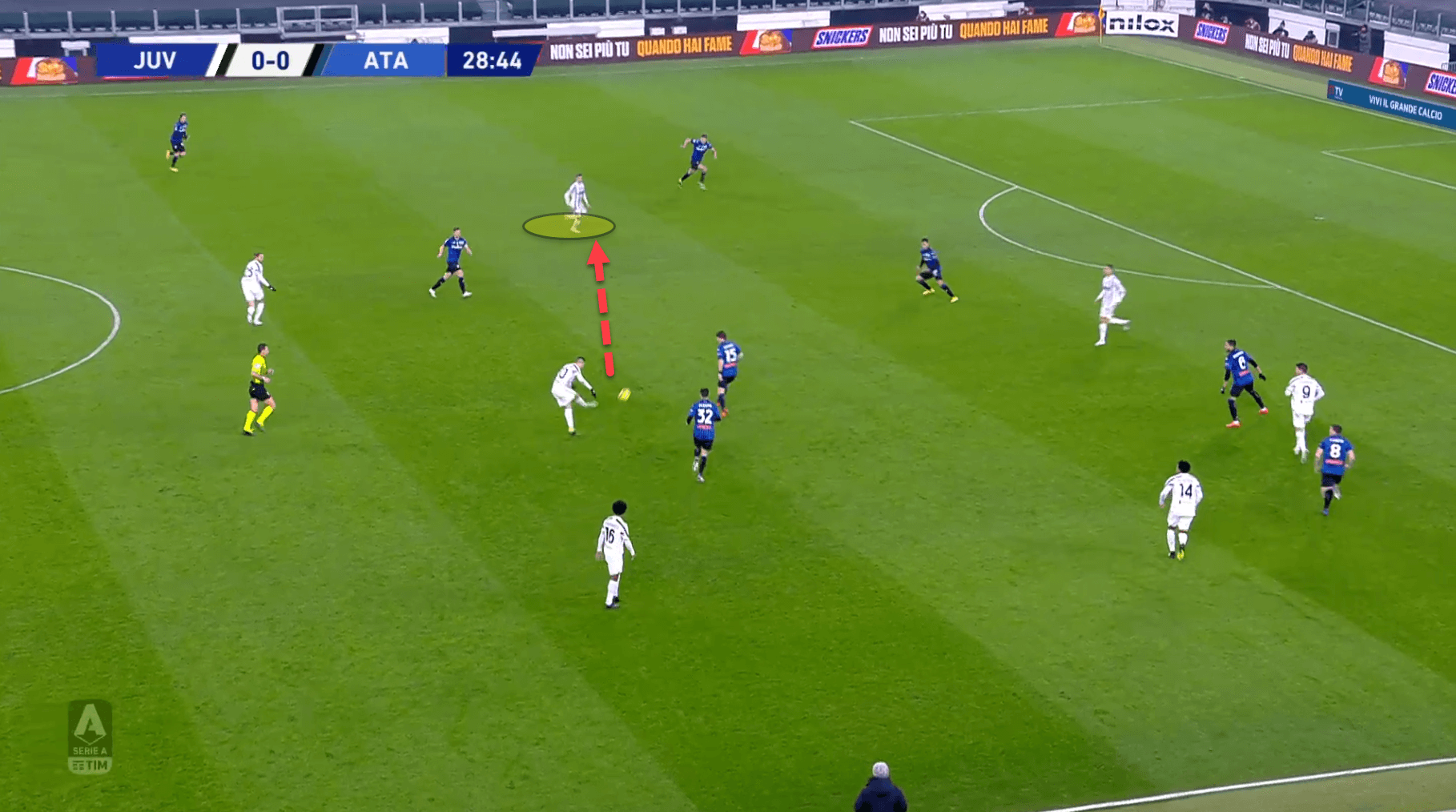
Juventus pressed high and won the ball back with a brilliant interception from Bentancur. The Uruguayan quickly got the ball out of his feet and played to Chiesa scored one of the best goals so far in Serie A this season to go 1-0 up.
Atalanta, on the other hand, lost the ball in the final third and counterpressed to win it back, which they did successfully with Remo Freuler, who hit the match’s second brilliant strike to level the game from a very similar position as Chiesa’s.
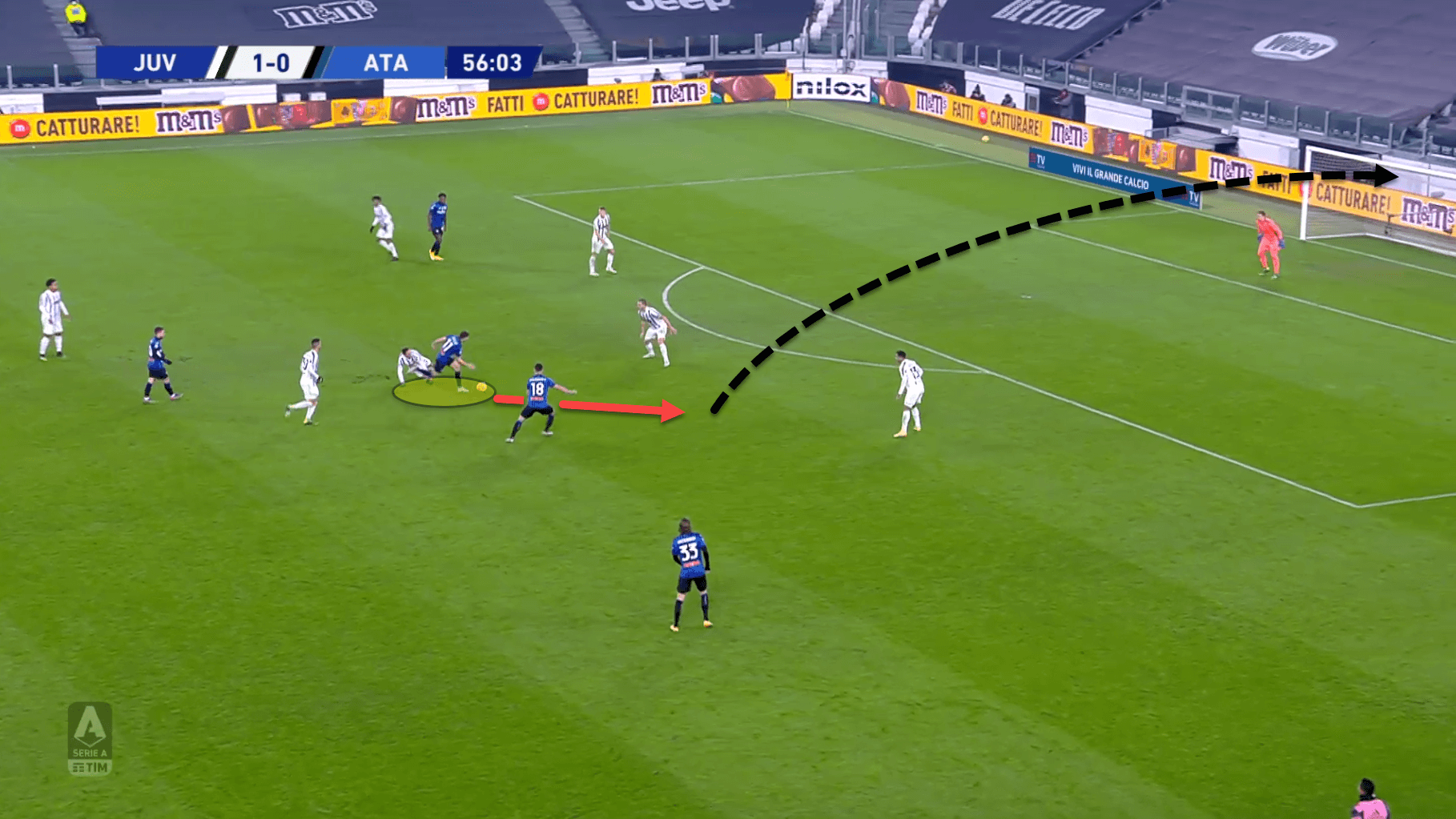
Conclusion:
As stated before, Juventus will quite possibly be the most disappointed from this draw as both Napoli and Milan dropped points on the same day, meaning three points would have closed their gap at the top to two points from Stefano Pioli’s side. Regardless, they have a reasonable run of fixtures to follow over the Christmas period with games against Parma, Fiorentina, and Udinese to come until their huge bout against Milan on the 6th of January.
Atalanta on the other hand should be quite happy with a point considering the number of quality chances that Juventus had in the game. In terms of expected goals (xG), Juventus finished with 2.4, whilst Gasperini’s side finished with 1.5. If La Dea can beat Roma at the weekend, a team that are three points ahead of them, they may be back on track to qualify for the UEFA Champions League for the third year in a row.






Comments